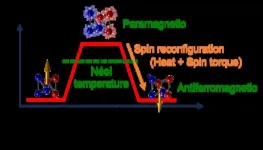(Press-News.org) A new analysis of satellite data finds that the record surge in atmospheric methane emissions from 2020 to 2022 was driven by increased inundation and water storage in wetlands, combined with a slight decrease in atmospheric hydroxide (OH). The results have implications for efforts to decrease atmospheric methane and mitigate its impact on climate change.
“From 2010 to 2019, we saw regular increases – with slight accelerations – in atmospheric methane concentrations, but the increases that occurred from 2020 to 2022 and overlapped with the COVID-19 shutdown were significantly higher,” says Zhen Qu, assistant professor of marine, earth and atmospheric sciences at North Carolina State University and lead author of the research. “Global methane emissions increased from about 499 teragrams (Tg) to 550 Tg during the period from 2010 to 2019, followed by a surge to 570 - 590 Tg between 2020 and 2022.”
Atmospheric methane emissions are given by their mass in teragrams. One teragram equals about 1.1 million U.S. tons.
One of the leading theories concerning the sudden atmospheric methane surge was the decrease in manmade air pollution from automobiles and industry during the pandemic shutdown of 2020 and 2021. Air pollution contributes hydroxyl radicals (OH) to the lower atmosphere. In turn, atmospheric OH interacts with other gases, such as methane, to break them down.
“The prevailing idea was that the pandemic reduced the amount of OH concentration, therefore there was less OH available in the atmosphere to react with and remove methane,” Qu says.
To test the theory, Qu and a team of researchers from the U.S., U.K. and Germany looked at global satellite emissions data and atmospheric simulations for both methane and OH during the period from 2010 to 2019 and compared it to the same data from 2020 to 2022 to tease out the source of the surge.
Using data from satellite readings of atmospheric composition and chemical transport models, the researchers created a model that allowed them to determine both amounts and sources of methane and OH for both time periods.
They found that most of the 2020 to 2022 methane surge was a result of inundation events – or flooding events – in equatorial Asia and Africa, which accounted for 43% and 30% of the additional atmospheric methane, respectively. While OH levels did decrease during the period, this decrease only accounted for 28% of the surge.
“The heavy precipitation in these wetland and rice cultivation regions is likely associated with the La Niña conditions from 2020 to early 2023,” Qu says. “Microbes in wetlands produce methane as they metabolize and break down organic matter anaerobically, or without oxygen. More water storage in wetlands means more anaerobic microbial activity and more release of methane to the atmosphere.”
The researchers feel that a better understanding of wetland emissions is important to developing plans for mitigation.
“Our findings point to the wet tropics as the driving force behind increased methane concentrations since 2010,” Qu says. “Improved observations of wetland methane emissions and how methane production responds to precipitation changes are key to understanding the role of precipitation patterns on tropical wetland ecosystems.”
The research appears in the Proceedings of the National Academy of Sciences and was supported in part by NASA Early Career Investigator Program under grant 80NSSC24K1049. Qu is the corresponding author and began the research while a postdoctoral researcher at Harvard University. Daniel Jacob of Harvard; Anthony Bloom and John Worden of the California Institute of Technology’s Jet Propulsion Laboratory; Robert Parker of the University of Leicester, U.K.; and Hartmut Boesch of the University of Bremen, Germany, also contributed to the work.
-peake-
Note to editors: An abstract follows.
“Inverse modeling of 2010-2022 satellite observations shows that inundation of the wet tropics drove the 2020-2022 methane surge”
DOI: 10.1073/pnas.2402730121.
Authors: Zhen Qu, North Carolina State University; Daniel Jacob, Harvard University; Anthony Bloom, John Worden, California Institute of Technology; Robert Parker,University of Leicester, U.K.; Hartmut Boesch, University of Bremen, Germany
Published: Sept. 24 in Proceedings of the National Academy of Sciences
Abstract:
Atmospheric methane concentrations rose rapidly over the past decade and surged in 2020-2022 but the causes have been unclear. We find from inverse analysis of GOSAT satellite observations that emissions from the wet tropics drove the 2010-2019 increase and the subsequent 2020-2022 surge, while emissions from northern mid-latitudes decreased. The 2020-2022 surge is principally contributed by emissions in Equatorial Asia (43%) and Africa (30%). Wetlands are the major drivers of the 2020-2022 emission increases in Africa and Equatorial Asia because of tropical inundation associated with La Nina conditions, consistent with trends in the GRACE terrestrial water storage data. In contrast, emissions from major anthropogenic emitters such as the US, Russia, and China are relatively flat over 2010-2022. Concentrations of tropospheric OH (the main methane sink) show no long-term trend over 2010-2022, but a decrease over 2020-2022 that contributed to the methane surge.
END
Saskatchewan education sector workers are experiencing disturbing levels of workplace violence and harassment, says a new report spotlighting a situation that has reached “a breaking point,” according to its authors.
Testimonies catalogued by University of Ottawa researchers found Saskatchewan schools are far from offering a safe and violence-free environment as workplace violence becomes increasingly normalized.
“I’ve been punched in the face, had push pins held to my eyeballs, and scissors held to my throat,” the report quotes one ...
Spintronics – devices that use microscopic magnetism in conjunction with electric current – could lead to computing technology as fast as conventional electronics but much more energy efficient. As such devices are developed and studied, an important unresolved question is how device operation is affected by heating.
A new experimental technique, reported by researchers at the University of Illinois Urbana-Champaign in the journal APL Materials, directly measures heating in spintronic devices, allowing direct comparison to other effects. The researchers say that this technique can be used to select spintronic materials whose magnetic behavior is minimally impacted by heating, ...
September 24, 2024-- The rate of e-bike and powered scooter injuries surged between 2019 and 2022-- by 293 percent and 88 percent, respectively, according to a new study at Columbia University Mailman School of Public Health. The research adds to the existing information and gap in knowledge on the sociodemographic and risk factor variables that might be contributing to micromobility vehicle–related injuries. The findings are published in the American Journal of Public Health.
Micromobility generally refers to any small, low-speed, human- or electric-powered transportation device. Between 2019 and 2022, e-bike sales increased by 269 ...
September 24, 2024-- New research conducted at Columbia Mailman School of Public Health and Mount Sinai School of Medicine shows a link between prediabetes among young people and adverse pregnancy outcomes later in life. The findings could alter how doctors routinely screen or counsel youth on blood glucose levels, and subsequently, minimize potential maternal and neonatal risks. The results are published in JAMA Network Open.
“This study is an important step in tying lifecourse cardiometabolic health to optimal pregnancy outcomes,” said Teresa Janevic, PhD, associate professor of Epidemiology at Columbia University Mailman School of Public Health and senior author. ...
The eye is an immune-privileged tissue because of the need to keep blood vessels away from the central pathway of light and to restrict entry of inflammatory cells that could cause damage. This has prompted questions about how the eye manages inflammation when it occurs.
A new study led by Thomas Jefferson University researchers has revealed insights into how the eye handles inflammation, particularly in autoimmune uveitis, an inflammatory disease that bypasses the eye’s immune privilege and can damage healthy eye tissue.
Previous studies by Jefferson researcher Sue Menko, PhD, revealed that immune cells ...
ROCKVILLE, MD – The Biophysical Society is pleased to announce that Daniel R. Larson, PhD, of the Center for Cancer Research at the National Cancer Institute within the National Institutes of Health, will receive the 2025 Carolyn Cohen Innovation Award. Larson will be honored at the Society’s 69th Annual Meeting, being held in Los Angeles, California from February 15-19, 2025.
Larson is being recognized for his pioneering contributions to the field of gene regulation using single-cell and single-molecule biophysical ...
ROCKVILLE, MD – The Biophysical Society is pleased to announce that James A. Glazier, PhD, of Indiana University, Bloomington, has been named the recipient of the 2025 Klaus Schulten and Zaida Luthey-Schulten Computational Biophysics Lecture Award. Glazier will be honored at the Society’s 69th Annual Meeting, being held in Los Angeles, California from February 15-19, 2025.
Glazier will be recognized for his development of algorithms, software, and models describing the emergent multicellular organization of development, homeostasis, and disease.
“I am delighted that the Biophysical Society is recognizing James’s pioneering work the ...
Many human medications can directly inhibit the growth and alter the function of the bacteria that constitute our gut microbiome. EMBL Heidelberg researchers have now discovered that this effect is reduced when bacteria form communities.
In a first-of-its-kind study, researchers from EMBL Heidelberg's Typas, Bork, Zimmermann, and Savitski groups, and many EMBL alumni, including Kiran Patil (MRC Toxicology Unit Cambridge, UK), Sarela Garcia-Santamarina (ITQB, Portugal), André Mateus (Umeå University, ...
The "popcorn planet" is back in the spotlight! Using NASA's James Webb Space Telescope (JWST), a team of international astronomers has discovered new atmospheric details on WASP-107b, an exoplanet with a puffed-up atmosphere due to tidal heating. Previously described as an extremely low-density "popcorn planet" by researchers, WASP-107b has once again proven to be an intriguing subject, revealing even more surprising characteristics about its inflated and dynamic atmosphere.
WASP-107b, a gas giant about the size of Jupiter but with just one-tenth of its mass, has ...
The lifeblood of any battery is the electrolyte. It is the medium through which positively charged elements (cations) migrate en masse between the positive and negative electrodes. By this means, batteries discharge to provide energy and charge to store energy. Scientists call this an electrochemical process.
Electrolytes are central to the development of different electrochemical processes, as well. For example, they could be used in converting iron ore into purified iron metal or iron alloys. A challenge is that the electrolyte must remain stable under extreme operating conditions and avoid side reactions that reduce energy efficiency. The payoff ...


